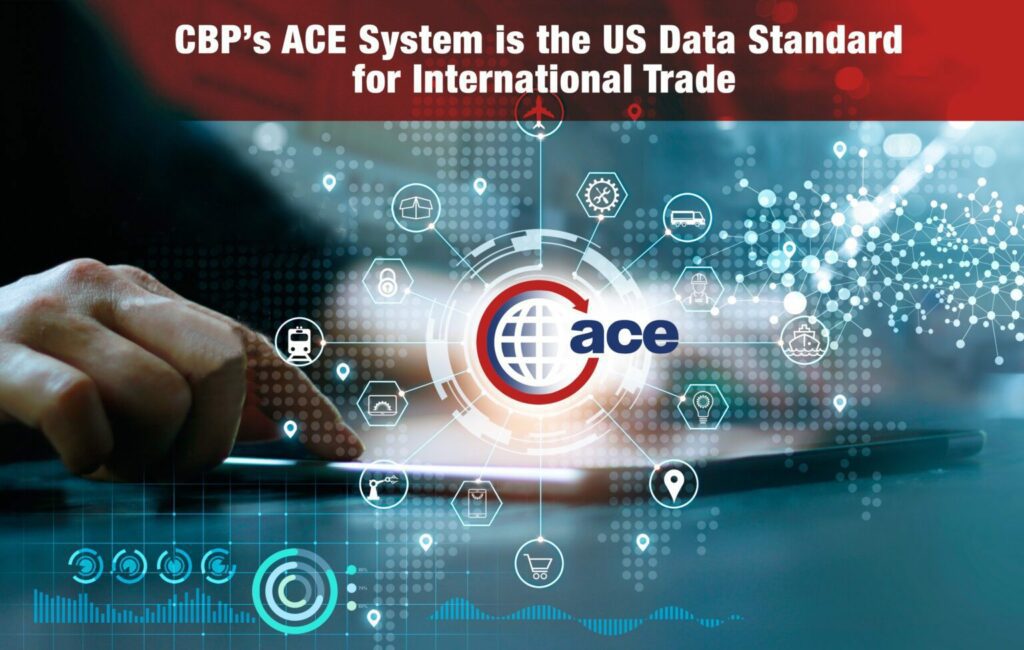Last week, the US Department of Transportation and the Federal Maritime Commission announced they intend to focus on data flow within the Port Community in an effort to speed up cargo movement through port terminals. We fully support this effort. However, their proposal of a study to develop a new data standard for international container transport is an inefficient use of time and money and will not help make the flow of container traffic faster.
Why? Because there is already a very powerful data standard in place. Any new standard would simply challenge it, and cause real headaches in the Port Terminal Community.
What is the current data standard? It’s the US Customs (CBP) Automated Commercial Environment (ACE) System. ACE is used every day, but is taken for granted so seldom spoken about. Let’s take a look at ACE from the perspective of judging it as a data standard.

The first question is whether the shipping process is covered in the data sets. YES! It certainly is! It begins with AMS, where the ocean carriers and NVOCC must manifest / file their bills of lading 24 hours before loading the cargo on board the vessels. Every single piece of data, with the exception of the Remarks, must be transmitted to ACE, and ACE is rigorous in its definition of the required data. ACE covers the length and type of data fields, acceptable port codes, carrier codes, bonded facility codes (FIRMS), commodity descriptions, vessel names, container number sequences, SCAC codes and more.
ACE also requires the ISF, which includes information about all commercial parties involved in the shipment. Customs Entry demands all the parties’ registration numbers, and precise classification of the inventory being shipped in accordance with the international Harmonized Commodity Description and Coding System (HS) for tariffs.
This would certainly begin to look like a robust data standard from the technical side.
Second, ACE covers all contingencies for cargo movement until the cargo is entered into the US commerce system, including the processes for entering US territory and the vessel’s arrival at the port of entry. It also includes in-bond movements for cargo moving beyond the Port Terminals; Permit to Transfer (PTT), Immediate Transportation Entry (IT), Immediate Export (IE), and Transport and Export (T&E).
So, transportation processes are covered by the ACE system as well.
Third, there is participation and enforcement. This is where any discussion of a new standard gets really silly, because currently:
a) Participation: Any and all parties wishing to transport cargo by any means to the United States must register for and adhere to the data exchange policies mandated by US CBP.
b) Enforcement: Failure to comply with CBP’s data standard at anything less than 100% results in penalties starting at a few thousand dollars and ending with potential jail time for failing to declare at all (also known as smuggling).
Last of all, CBP shares their data standard within the Port Terminal Community. All carriers, both VOCC and NVOCC, and the terminals, container freight stations, and Customs Brokers are informed when there is a release or a hold. All these parties can see the status of the shipment movement at any time via information available or queried through the ACE system.
So, a powerful, effective data standard already exists. That doesn’t mean we shouldn’t be expanding our ability to share information to get better results but that is a different discussion, and it is the discussion we should be having.
Our recommendations:
1) CBP should be involved in the discussions being initiated by the Department of Transportation.
2) CBP should agree to process Customs Entries from the time the vessel leaves the Port of Loading. This will remove the primary potential holdup on cargo at the destination ports. The sooner all parties know the cargo is released, the further in advance they can begin planning for pickup and delivery.
3) Terminals need to plan their stacks prior to vessel arrival based on known pickup and delivery appointments.
4) The working group should focus on how importers and terminals can collaborate in advance for the pickup and delivery of cargo days ahead of the vessel’s arrival at the terminal.
The gap between information systems is the gap between the importer and the terminal. THIS is the gap that needs to be addressed and it should be addressed using the existing data standard already in place in the USA today – CBP’s ACE System and the systems that interact with it at both origin and destination.



